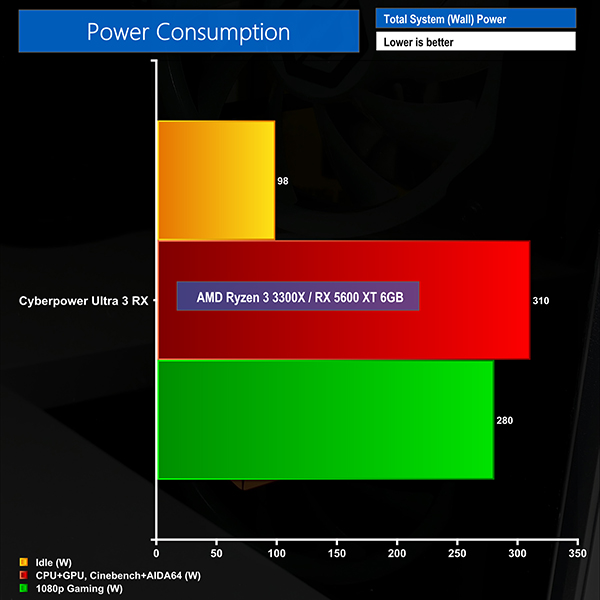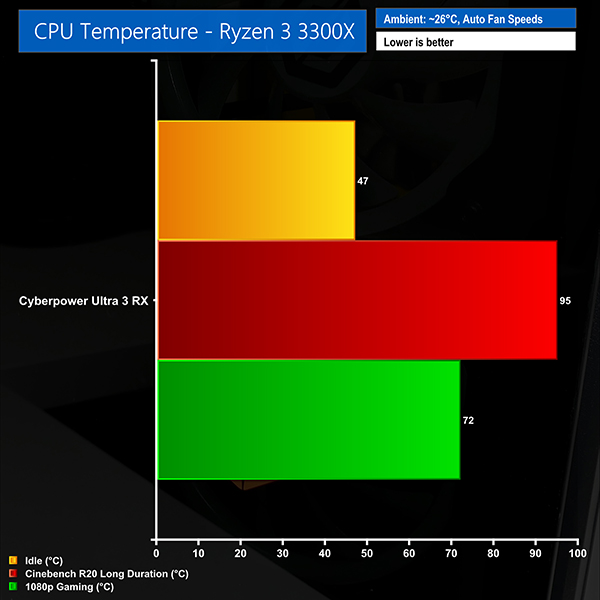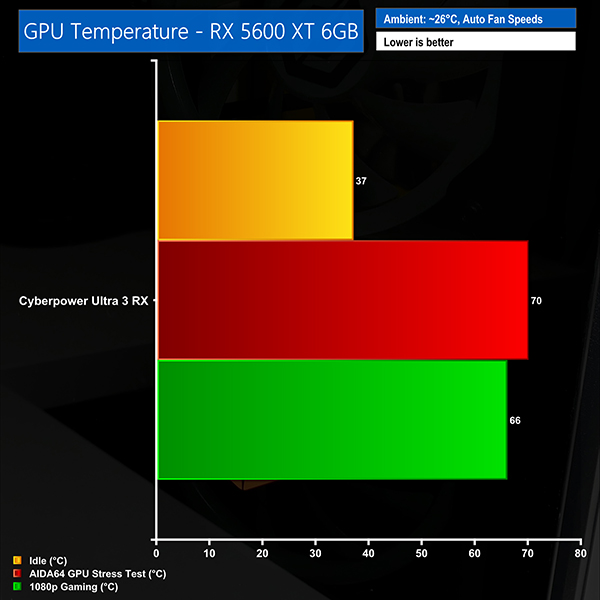System Power Consumption
For CPU plus GPU load results, we run Cinebench R20 nT and AIDA64 GPU stress tests and take a reading. Gaming readings are taken when running Red Dead Redemption 2 at 1080p.
The power consumption of our entire test system (at the wall) is shown in the chart.
Idle power draw was just shy of 100W for the entire system. This number increased to around 155W for a CPU-only Cinebench load. 310W was the reading from the wall with both the CPU and GPU heavily loaded by Cinebench and AIDA64. Loading only the graphics card in AIDA64 resulted in 250W wall power. Running RDR2 at 1080P saw peak system power at around 280W as the CPU was not 100% utilised.
Clearly, a peak power draw below the mid-300 Watts level is no major concern for the 80-Plus InWin 550W power supply.
System Temperatures
We use the same test procedure to record system temperatures. Ambient temperature during the readings was around 26-27°C.
The CPU idled at around 50C using the Wraith cooler but this cycled by around 10C as the idle clock speeds ramped up and down. Cinebench R20 on its own saw the CPU increasing to around 85C after five minutes of loading but this would eventually climb higher as the heatsink became more thermally saturated.
Applying a long duration CPU load and pumping heat from the graphics card into the chassis saw the Ryzen 3 3300X peak at 95C. This is fine, though, as the PB2 algorithm will simply reduce clock speeds and voltages accordingly to maintain stable operation. We actually saw only a small drop in frequency of around 25-50MHz at this point.
The lower demand of gaming proved of little challenge for the Wraith CPU cooler as the high-frequency Ryzen 3 3300X operated just above 70C.
The GPU idled below 40C as the software readings suggested the card did not operate with a zero RPM fan mode. Loading just the graphics card in AIDA64 increased the temperature to 70C with a fan speed just above 50%. Adding in the cooling challenge of a CPU load did not increase GPU temperature beyond 70C but the fan did operate higher at 56% or 1970 RPM.
Gaming saw the graphics card drop a few degrees off its stress test levels and run at 66C with a peak fan speed of just over 50% through our entire RDR2 run.
We were happy with the GPU cooling for the dual-fan, 2.5 slot cooler. No complaints from a thermal perspective.
Clocks
In terms of clock speeds, we observed around 4.1GHz from the Ryzen 3 3300X CPU even when the Wraith cooler was pushed hard. At 95C, when the GPU was also being loaded, we observed drops to around 4.075GHz but this is what we would consider to be minor.
The GPU steadily hummed along at 1731MHz – just shy of its 1750MHz rated Boost Clock
System Noise
Noise performance is ‘OK‘, but certainly not particularly good.
Idle and light load operating conditions represent the most disappointing noise levels as the chassis fans did not spin down and were therefore clearly audible when they did not need to be. This is due to the routing of the fan connections to the RGB control hub rather than speed-controlled motherboard headers.
Applying a load to the CPU does add some noticeable noise from the Wraith cooler but it is not particularly obtrusive over the chassis fans.
The graphics card fans are very quiet and do not add considerable noise output to the system. When the CPU cooler fan is running at full speed alongside the chassis fans, the graphics card cooler operating at around 50% is not noticeable.
We reported reasonable noise output overall but the noise levels are more respectable under load rather than idle conditions. Make sure to check out our video review for examples of the noise output.
 KitGuru KitGuru.net – Tech News | Hardware News | Hardware Reviews | IOS | Mobile | Gaming | Graphics Cards
KitGuru KitGuru.net – Tech News | Hardware News | Hardware Reviews | IOS | Mobile | Gaming | Graphics Cards





